Jump from orbit

The meteorite hit the spacecraft, and the crew started a very bad day. The engines, or heat shield, or some other important detail were damaged, and the ship lost the ability to return from orbit on its own. What to do? Such questions occurred to engineers at the beginning of the space age. Moreover, at that time, the density of meteorites in space was very much overestimated, and the silent satellite was considered by default to be destroyed by a meteorite impact. Somehow it was necessary to save people. But to return from orbit, you need a separate engine, you need a spare heat shield to withstand the heat from deceleration in the atmosphere, you need a separate parachute. All this should be small and light, because in spaceships every gram and cubic centimeter is worth its weight in gold. A heat shield also had to be a certain form. Therefore, the projects of minimalistic rescue equipment were inflatable.
MOOSE
In the early 60s, General Electric developed the MOOSE project. The abbreviation was originally deciphered as Man Out Of Space Easiest - The Easiest Way To Get Man Out Of Space, and may have been a parody of the MISS - Man In Space Soonest (Managed Space to Man), a manned 1958 US Air Force program. Then the project came up with a more "serious" name - Manned Orbital Operations Safety Equipment (Rescue Equipment For Work In Orbit). And “moose” is in English “elk”. In a small container, about the size of a suitcase and weighing 90 kg (according to other data 130 kg), the engineers managed to place a small engine for braking from orbit, foam cylinders, which was supposed to be a filler and shock absorber, a folding form with thermal protection, a parachute, a radio and survival kit.
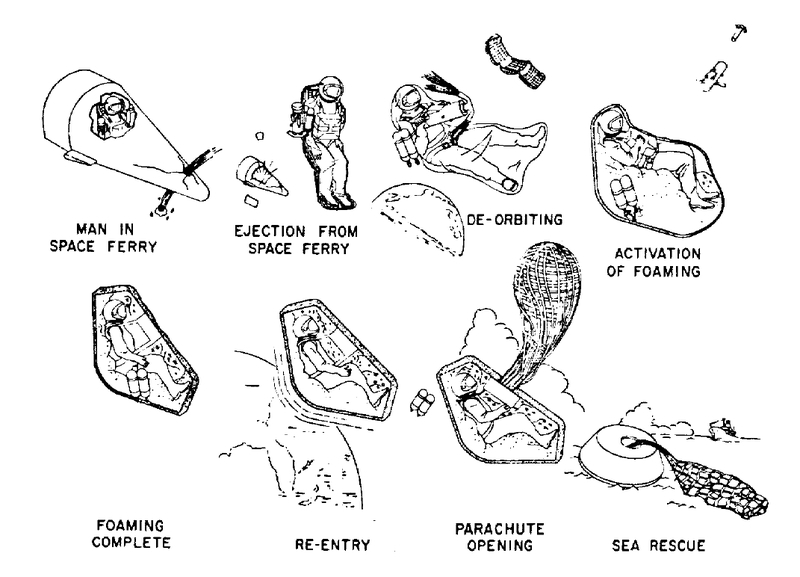
')
In case of serious problems with the ship, the astronaut had to get out, slow down with a rocket engine in his hands, climb into a folding container and blow free space out of the foam. The foam gave the shape of an aerial shell with thermal protection, the aerial shell “vanka-vstanka” maintained the correct position in the atmosphere, a parachute was automatically inserted at an altitude of 9 km, and when it touched the surface it also served as a shock absorber.
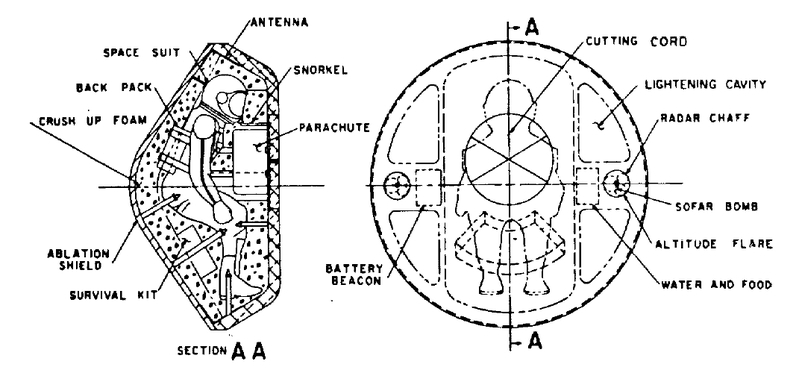
The project was partially tested - an element of thermal protection flew on the "Mercury", volunteers were packed in foam, mannequins in full-size mock-ups were dropped from a small height to check the impact on the ground. A successful parachute jump by Joseph Kittinger from a height of 31 kilometers, although not connected with the program, added confidence in the feasibility of the project. MOOSE could become a regular rescue tool for X-20 mini-shuttles , which were supposed to meet not only with meteorites, but also with the need to inspect / steal / destroy possibly mined Soviet satellites, or even participate in space exchange. But the X-20 program was stopped, and neither NASA nor the US Air Force showed further interest in the MOOSE. The project was quietly put on the shelf at the end of the 60s, although the work on it was probably used by the same company for the General Electric Lifeboat project (GE Life Raft) of 1966, where the crew consisted of 3 people and the aerial shell was tough.

Paracone
In 1963, another company, Douglas, offered its own version, very technologically similar, but favorably distinguished by being embedded in an ejection seat and replacing a parachute with a large badminton shuttlecock.
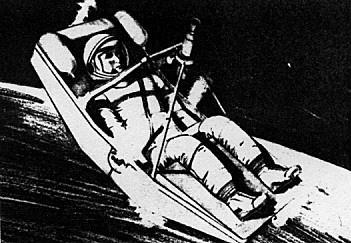
After ejection, front brake motor

Expanded "shuttlecock"
A large area and a small mass of an inflatable cone theoretically allowed refractory materials to be used instead of ablative thermal shields (Rene-41 alloy, as on the X-20), and at a small height the cone would brake to approximately 40 km / h. The impact on the ground was supposed to take on the crumpling lower part of the cone. The mass of the system was expected to be comparable with MOOSE.

SAVER
Another interesting engineering option offered by the company Rockwell. Here, instead of a cone, it was proposed to inflate a huge balloon, the material of which was supposed to withstand inhibition in the atmosphere.
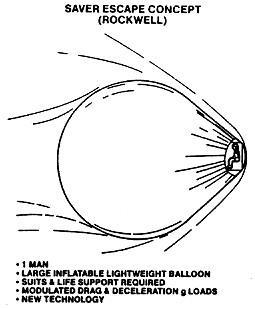
Spiral
On the Spiral mini-shuttle, Soviet designers went the other way — the rescue capsule was tough:
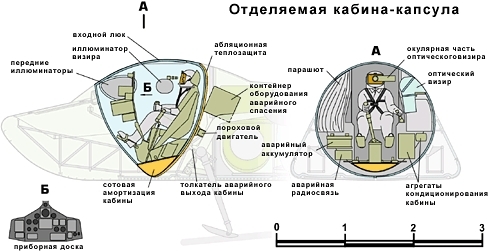
The capsule had to be braked by a simple solid-fuel engine, braked in the atmosphere with the help of the ablative thermal protection already mastered on other devices, descended by parachute and extinguish the impact of the shock absorber against the surface.
More projects
In the English-language Internet you can find information about the Soviet capsule of Umansky from 1965. According to the description, it had to be rigid and could be used not only for rescue, but also for work in orbit. Similar projects of hard maneuvering capsules were in the United States, for example, the sketch of the 1975 MOSES:
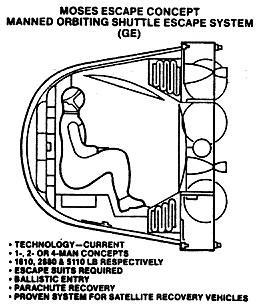
A non-maneuvering folding capsule, in fact, a bag for a man, was offered as a life-saving tool for the Space Shuttles. This bag was supposed to pull the astronaut in a spacesuit behind him, moving one crew of a distressed shuttle to another rescue shuttle.
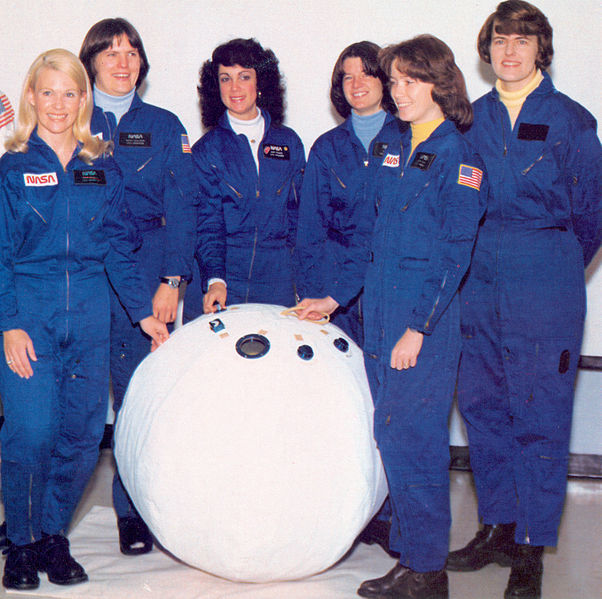
The shuttle returns
The simplicity of the inflatable tapered brake concept means that such projects will reappear. In this way, the penetrators of the Mars-96 probe were supposed to slow down in the atmosphere of Mars. NGO them. Lavochkina conducted test launches of such cones and proposed a parachute-free rescue system “Savior”:

Partially, the inflatable parachute technology is used in the LDSD “flying saucer” from NASA, and even at Geektimes you can find a student diploma with such a “frill”. But unmanned cosmonautics, as Alexander Ivanovich Privalov would say, is another story.
Advantages and disadvantages
The fact that these projects did not go into the series is logical. The danger of meteorites was much less, and, fortunately, there was no exchange of fire in space. And it is good, because as a means of salvation, such constructions are very so-so. It is very difficult to manually set the correct orientation for braking with such primitive means and to brake while keeping the engine in hand (“Gravity” and “Martian” deceive you in this matter). The accuracy of the landing is obtained "approximately here in this continent", the miss will be hundreds of kilometers. Ballistic descent is the 9 “same”, which is very uncomfortable. In general, it is easier and more efficient to take measures to improve the reliability of spacecraft.
What would it look like
The fact that no one in reality jumped from space does not prevent us from jumping into virtuality. Orbiter has an X-20 addon that has MOOSE. Fly!
Handsome X-20 with an overclocking block TransStage in flight

The first task is to combine the plane of the orbit with Cape Canaveral, where we hope to land.
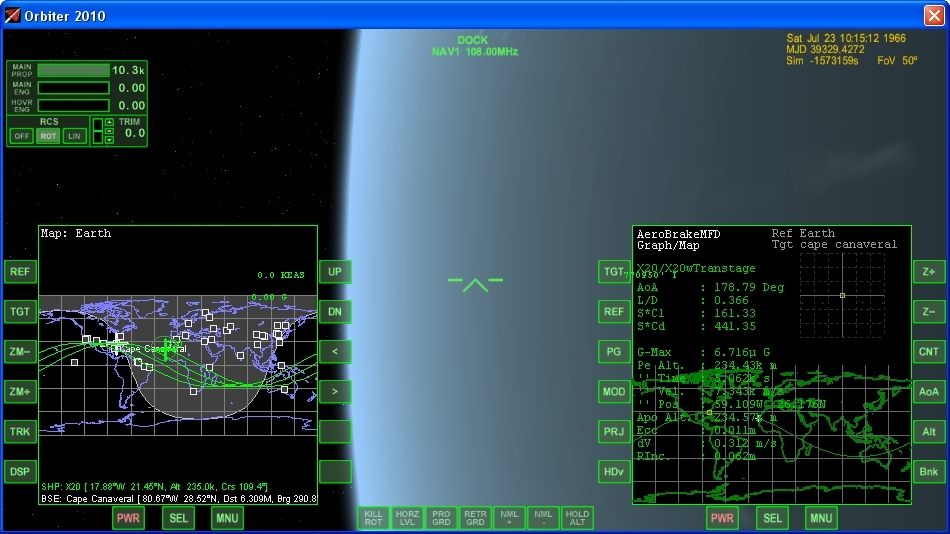
Catapult!

According to the add-on developer, the engine would be located in the ejection seat, and you would have to turn your feet forward to brake. We are braking so as to hit the target as accurately as possible (a real pilot would not have such accurate sensors and engines).

If I were a pilot, I would be scared - the shape of the aero shell is completely wrong.

Well, right, 8 "same", as warned.

And only here, at an altitude of five kilometers, I remembered that there are a lot of crocodiles on Cape Canaveral ...
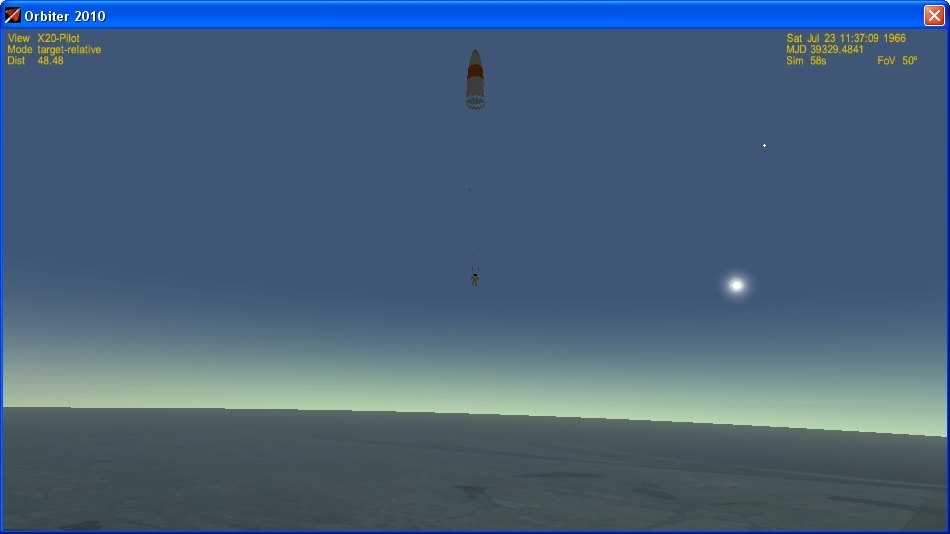
The final slip turned out just 74 km from the launch pads. And no crocodiles - landing very close to the tourist center.
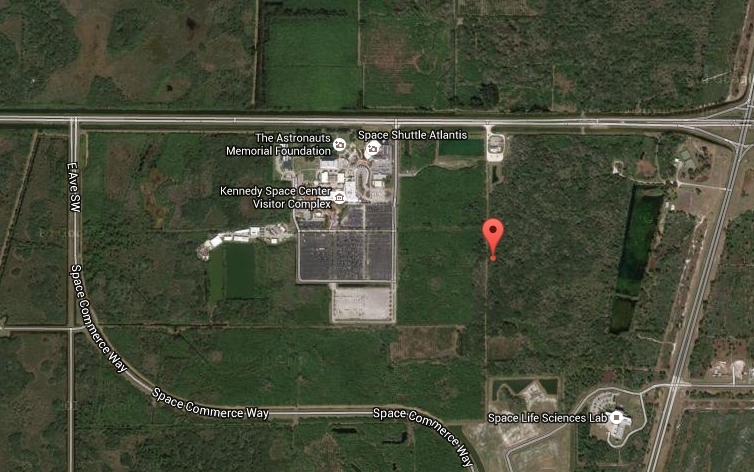
By Orbiter tag other space adventures with real physics.
Small announcement : June 7 at 19:00 in the Ufa Planetarium will be my lecture “Heavenly mechanics without a single formula” , after which it will be much easier for you to become a virtual space pilot. Free admission.
Source: https://habr.com/ru/post/394721/
All Articles